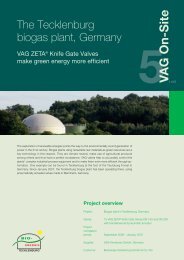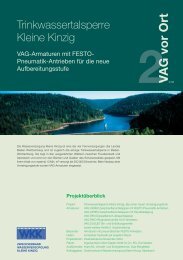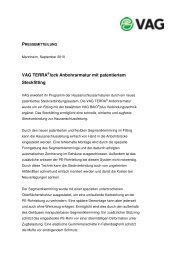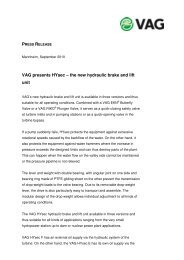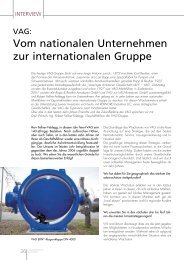Butterfly valves in municipal water management - VAG Armaturen
Butterfly valves in municipal water management - VAG Armaturen
Butterfly valves in municipal water management - VAG Armaturen
You also want an ePaper? Increase the reach of your titles
YUMPU automatically turns print PDFs into web optimized ePapers that Google loves.
<strong>Butterfly</strong> <strong>valves</strong> <strong>in</strong> <strong>municipal</strong><br />
<strong>water</strong> <strong>management</strong><br />
Peter Opp<strong>in</strong>ger, Market<strong>in</strong>g Manager, <strong>VAG</strong>-<strong>Armaturen</strong> GmbH, 68305 Mannheim/Germany<br />
Published <strong>in</strong> Industrial Valves 2010/2011 · Vulkan-Verlag Essen/Germany
<strong>Butterfly</strong> <strong>valves</strong> <strong>in</strong> <strong>municipal</strong><br />
<strong>water</strong> <strong>management</strong><br />
Peter Opp<strong>in</strong>ger<br />
<strong>Butterfly</strong> <strong>valves</strong> of various types have been manufactured for more than 50 years. They have stood<br />
the test of time <strong>in</strong> a wide variety of operat<strong>in</strong>g conditions throughout the world. Without butterfly<br />
<strong>valves</strong> modern <strong>water</strong> <strong>management</strong> would be <strong>in</strong>conceivable. <strong>Butterfly</strong> <strong>valves</strong> play an important role<br />
wherever <strong>water</strong> is stored, transported, treated and distributed. What counts most are durability and<br />
decades of functional reliability. Valves used <strong>in</strong> <strong>water</strong> <strong>management</strong> have to withstand enormous<br />
loads, high <strong>water</strong> pressures, critical flow velocities as well as extreme temperatures and weather<br />
conditions, whether <strong>in</strong> tropical climates or <strong>in</strong> the desert. Therefore the materials of construction have<br />
to be just right. That’s because moderniz<strong>in</strong>g <strong>valves</strong>, which can often weigh tonnes, is very costly,<br />
particularly <strong>in</strong> major supply l<strong>in</strong>es. <strong>VAG</strong> <strong>valves</strong> help to precisely control the complex process<strong>in</strong>g<br />
systems required for this and to make them even more efficient through automation.<br />
Design<br />
<strong>Butterfly</strong> <strong>valves</strong> are isolat<strong>in</strong>g <strong>valves</strong> <strong>in</strong><br />
which the closure device – the valve<br />
disk – rotates on its own axis parallel or<br />
perpendicular to the flow. Depend<strong>in</strong>g<br />
on the type of construction and <strong>in</strong>stallation<br />
the valve disk is positioned either<br />
horizontally or vertically <strong>in</strong> the pipel<strong>in</strong>e<br />
with the medium flow<strong>in</strong>g around it.<br />
Accord<strong>in</strong>g to DIN EN 593 (formerly<br />
DIN 3354) designs are differentiated<br />
by the type of connection and the shaft<br />
bear<strong>in</strong>g of the valve disk. The type of<br />
connection is called a double flange<br />
butterfly valve (Figure 1) or a wafer<br />
type butterfly valve (Figure 2).<br />
With respect to shaft bear<strong>in</strong>gs a difference<br />
is made among<br />
� butterfly valve with centric shaft bear<strong>in</strong>g<br />
� butterfly valve with eccentric shaft<br />
bear<strong>in</strong>g<br />
� butterfly valve with double eccentric<br />
shaft bear<strong>in</strong>g<br />
Tightness of the seal is one of the most<br />
important criteria of butterfly <strong>valves</strong>.<br />
That is why both the seal<strong>in</strong>g system and<br />
seal<strong>in</strong>g k<strong>in</strong>ematics (geometry of motion)<br />
are of great significance for a 100 %<br />
tight seal. For butterfly <strong>valves</strong> with centric<br />
shaft bear<strong>in</strong>g no seal<strong>in</strong>g force component<br />
results from the rotational movement.<br />
For soft seated butterfly <strong>valves</strong><br />
seal<strong>in</strong>g takes place when there is<br />
enough surface pressure between the<br />
elastomer of the closure device (disk)<br />
and the seal<strong>in</strong>g seat <strong>in</strong> the hous<strong>in</strong>g.<br />
The advantage of a double eccentric<br />
bear<strong>in</strong>g is that the disk’s po<strong>in</strong>t of rota-<br />
Fig. 1: <strong>VAG</strong> EKN ® <strong>Butterfly</strong> Valve with flanges<br />
tion lies both horizontally and vertically<br />
outside of the seal<strong>in</strong>g plane. In open<br />
position the disk is located either above<br />
or below the pipe axis. In open position<br />
the seal<strong>in</strong>g r<strong>in</strong>g, also referred to as a<br />
profile r<strong>in</strong>g, for the most part arranged<br />
directly on the disk is unstressed over<br />
the entire circumference. In this way no<br />
deformations of the profile r<strong>in</strong>g will take<br />
place even when <strong>in</strong> prolonged open<br />
position. Another advantage of double<br />
eccentric butterfly <strong>valves</strong> is shown by<br />
sizes above DN 1000. The profile r<strong>in</strong>g
Fig. 2: <strong>VAG</strong> CEREX ® 300 <strong>Butterfly</strong> Valve<br />
wafer type<br />
can then be replaced <strong>in</strong> <strong>in</strong>stalled state<br />
without hav<strong>in</strong>g to disassemble the disk<br />
or remove the valve from the pipel<strong>in</strong>e.<br />
Soft seated butterfly <strong>valves</strong> are usually<br />
manufactured <strong>in</strong> a nom<strong>in</strong>al size range<br />
of up to several meters <strong>in</strong> diameter and<br />
at pressure rat<strong>in</strong>gs of more than 40 bar.<br />
In addition, a difference is made between<br />
medium-contact<strong>in</strong>g and medium<br />
non-contact<strong>in</strong>g body designs. <strong>Butterfly</strong><br />
<strong>valves</strong> with centric bear<strong>in</strong>g are predom<strong>in</strong>antly<br />
not made with medium-contact<strong>in</strong>g<br />
hous<strong>in</strong>gs. An elastomer is used here<br />
as a body l<strong>in</strong><strong>in</strong>g which at the same time<br />
provides the body corrosion protection.<br />
butterfly <strong>valves</strong> with double eccentric<br />
bear<strong>in</strong>g are almost always medium-contact<strong>in</strong>g.<br />
However, for use <strong>in</strong> <strong>municipal</strong><br />
<strong>water</strong> supply the <strong>in</strong>ner surfaces are usually<br />
given an epoxy-based coat<strong>in</strong>g for<br />
corrosion protection.<br />
Highest demands on valve<br />
technology<br />
The protection of our environment requires<br />
sophisticated systems and process<strong>in</strong>g<br />
technology. Thus, the demands<br />
of consultants and operators of <strong>water</strong><br />
technology plants on functional safety<br />
and reliability are also greater. In addition,<br />
<strong>in</strong> the selection of <strong>valves</strong> from an<br />
economic viewpo<strong>in</strong>t, consultants, planners,<br />
plant manufacturers and operators<br />
are <strong>in</strong>creas<strong>in</strong>gly focus<strong>in</strong>g on all-purpose<br />
products with <strong>in</strong>stallation advantages<br />
and a high degree of operational reliability.<br />
The highest demands of quality<br />
and user-friendl<strong>in</strong>ess are be<strong>in</strong>g made<br />
on <strong>valves</strong>. All components must enable<br />
the absolute trouble-free and fully automated<br />
operation of <strong>water</strong> treatment and<br />
supply facilities.<br />
The type of coat<strong>in</strong>g and associated certification<br />
is of the utmost importance <strong>in</strong><br />
the selection of <strong>valves</strong>. Valves with the<br />
RAL quality mark meet the requirements<br />
for “heavy-duty corrosion protection”.<br />
This guarantees the user a perfect and<br />
Fig. 4:<br />
Porosity test<strong>in</strong>g the<br />
coat<strong>in</strong>g on a <strong>VAG</strong><br />
EKN ® <strong>Butterfly</strong> Valve<br />
Fig. 3: Coat<strong>in</strong>g thickness test on a <strong>VAG</strong> EKN ® <strong>Butterfly</strong> Valve<br />
tested epoxy-based coat<strong>in</strong>g quality and<br />
thus safe and reliable coat<strong>in</strong>g suitable<br />
for use <strong>in</strong> dr<strong>in</strong>k<strong>in</strong>g <strong>water</strong> systems<br />
(Figure 3). In the present state of the art,<br />
epoxy technology is the most advanced<br />
coat<strong>in</strong>g process. This entails spray<strong>in</strong>g<br />
the sandblasted and heated valve hous<strong>in</strong>g<br />
with coat<strong>in</strong>g powder which then<br />
melts. An all-round coat<strong>in</strong>g with an average<br />
layer thickness of 250 microns<br />
guarantees maximum adhesion and<br />
long-term protection from external <strong>in</strong>fluences.<br />
The RAL quality mark is only<br />
awarded to manufacturers who satisfy<br />
the high demands of comprehensive<br />
quality assurance (Figure 4).<br />
Dr<strong>in</strong>k<strong>in</strong>g <strong>water</strong> must be free from<br />
pathogens, fit for human consumption
Fig. 5: <strong>VAG</strong> EKN ® <strong>Butterfly</strong> Valve DN 4000<br />
and pure. Consumer confidence <strong>in</strong> the<br />
dr<strong>in</strong>k<strong>in</strong>g <strong>water</strong> supply is high and a<br />
DVGW (German Technical and Scientific<br />
Association for Gas and Water)<br />
certificate shows that the acknowledged<br />
high standards of performance<br />
are fulfilled for German <strong>water</strong> supply<br />
systems. Among other th<strong>in</strong>gs, each<br />
valve must be fit for purpose, tested<br />
with 2500 load cycles. Moreover, certification<br />
of the elastomers used (for the<br />
profile seal<strong>in</strong>g r<strong>in</strong>g made of EPDM) assures<br />
no negative micro-bacteriological<br />
growth <strong>in</strong> accordance with DVGW<br />
worksheet W 270. <strong>VAG</strong> <strong>Butterfly</strong><br />
Valves meet all of these requirements to<br />
the fullest extent.<br />
Range of use of <strong>VAG</strong> EKN ®<br />
<strong>Butterfly</strong> Valves<br />
<strong>VAG</strong>-<strong>Armaturen</strong> is expand<strong>in</strong>g its range<br />
of butterfly <strong>valves</strong> to <strong>in</strong>clude diameters of<br />
up to DN 4000. The long established<br />
and proven <strong>VAG</strong> EKN ® <strong>Butterfly</strong> Valve<br />
is available <strong>in</strong> all nom<strong>in</strong>al diameters<br />
from DN 100 to DN 4000 (Figure 5).<br />
In addition to the tried and tested F4<br />
series, a “short pattern” series (<strong>in</strong> accordance<br />
with EN 558-1, basic series 13,<br />
formerly DIN 3202, F16) up to DN<br />
1500 is now available. The new double<br />
flange butterfly valve design now<br />
provides an all-purpose <strong>in</strong>stallation op-<br />
tion of the valve, even at full differential<br />
pressure. The 100 % tightness of both<br />
flow directions is assured by means of<br />
Fig. 6: Large variety of <strong>VAG</strong> EKN ® <strong>Butterfly</strong> Valve models<br />
a pressure-assisted profile seal<strong>in</strong>g r<strong>in</strong>g.<br />
Depend<strong>in</strong>g on the nom<strong>in</strong>al diameter,<br />
the <strong>VAG</strong> EKN ® <strong>Butterfly</strong> Valve can now<br />
be used at operat<strong>in</strong>g pressures of more<br />
than 50 bar. When the valve is closed<br />
the pipel<strong>in</strong>e can be dismantled on one<br />
side even under operat<strong>in</strong>g pressure. All<br />
of these advantages result <strong>in</strong> the reduction<br />
of potential <strong>in</strong>stallation errors dur<strong>in</strong>g<br />
on-site assembly and thus greatly <strong>in</strong>crease<br />
safety dur<strong>in</strong>g assembly: The<br />
EKN ® <strong>Butterfly</strong> Valve is the universal<br />
standard valve and provides the user<br />
significant advantages compared to<br />
other commonly available butterfly<br />
<strong>valves</strong>.<br />
A high degree of operational reliability<br />
is assured from unrestricted tightness <strong>in</strong><br />
both flow directions. The double O-r<strong>in</strong>g<br />
seal<strong>in</strong>g <strong>in</strong> the shaft bear<strong>in</strong>g, the closed<br />
bear<strong>in</strong>g eyes <strong>in</strong> the area of the axle<br />
bear<strong>in</strong>g and a hous<strong>in</strong>g seat seal<br />
as nickel plat<strong>in</strong>g enable reliable longterm<br />
operation, even over de-cades.<br />
Figure 6 shows the universal comb<strong>in</strong>ations<br />
of materials that can be achieved<br />
with the <strong>VAG</strong> EKN ® <strong>Butterfly</strong> Valve.
The ma<strong>in</strong> field of application of the<br />
<strong>VAG</strong> EKN ® <strong>Butterfly</strong> Valve is <strong>in</strong> <strong>municipal</strong><br />
<strong>water</strong> supply. Beg<strong>in</strong>n<strong>in</strong>g with <strong>water</strong><br />
delivery, transport l<strong>in</strong>es, <strong>in</strong> use <strong>in</strong> <strong>water</strong><br />
treatment plants to dr<strong>in</strong>k<strong>in</strong>g <strong>water</strong> supply<br />
networks, where the <strong>VAG</strong> EKN ®<br />
<strong>Butterfly</strong> Valve has stood the test of time<br />
over decades <strong>in</strong> many projects throughout<br />
the world.<br />
Actuators for butterfly <strong>valves</strong><br />
By means of actuators external forces<br />
are transmitted to the disk <strong>in</strong> order to<br />
safely and reliably move it <strong>in</strong> any operat<strong>in</strong>g<br />
situation. butterfly <strong>valves</strong> are<br />
equipped with mechanical, electric,<br />
pneumatic or hydraulic actuators. butterfly<br />
<strong>valves</strong> with mechanical actuators<br />
(predom<strong>in</strong>antly with manual worm<br />
gears) are employed <strong>in</strong> plants as well<br />
as underground. Valves with electric or<br />
pneumatic actuators are used to automate<br />
plants. If performance and safety<br />
of the <strong>water</strong> supply system is essential<br />
then t, <strong>valves</strong> with hydraulic actuators<br />
are predom<strong>in</strong>antly used. For the most<br />
part as a hydraulic brake and lift cyl<strong>in</strong>der,<br />
e. g., <strong>in</strong> pump<strong>in</strong>g stations as a<br />
“controlled” non-return valve with controlled<br />
clos<strong>in</strong>g movement. You can efficiently<br />
and safely move the valve us<strong>in</strong>g<br />
the electro-hydraulic control. The modular<br />
design of the <strong>VAG</strong> HYsec brake and<br />
lift cyl<strong>in</strong>der permits use <strong>in</strong> a variety of<br />
applications. Additional features can<br />
be implemented quickly and easily by<br />
add<strong>in</strong>g various modules. For check<br />
<strong>valves</strong>, for example, that must be acti-<br />
Fig. 7: <strong>VAG</strong> EKN ® <strong>Butterfly</strong><br />
Valve with <strong>VAG</strong> HYsec<br />
hydraulic brake and lift unit<br />
vated as quick open<strong>in</strong>g <strong>valves</strong> without<br />
auxiliary power. Or as comb<strong>in</strong>ed quick<br />
clos<strong>in</strong>g and control devices.<br />
In comb<strong>in</strong>ation with a switch or signall<strong>in</strong>g<br />
unit, brake and lift cyl<strong>in</strong>ders always<br />
deliver high performance even for<br />
this application. Wherever brake and<br />
lift cyl<strong>in</strong>ders from <strong>VAG</strong> are used the<br />
highest level of safety must is assured<br />
(Figure 7). <strong>VAG</strong> HYsec brake and lift<br />
units <strong>in</strong>tegrate all drive, actuator and<br />
control units <strong>in</strong> a compact assembly.<br />
The ready to operate unit is available<br />
for delivery <strong>in</strong> your option of mounted<br />
term<strong>in</strong>al or control box. The unit only<br />
needs to be connected to the power<br />
supply to be put it <strong>in</strong>to operation. The<br />
valve and actuator are ready for operation<br />
<strong>in</strong> just a few steps. The actuators<br />
are also well prepared for <strong>in</strong>dividual<br />
use. Actuat<strong>in</strong>g times can be easily and<br />
<strong>in</strong>dividually set on site and the adjustable<br />
flow controller assists <strong>in</strong> this.<br />
Installation guidel<strong>in</strong>es for butterfly<br />
<strong>valves</strong><br />
To ensure the best possible flow conditions,<br />
butterfly <strong>valves</strong> should never be<br />
<strong>in</strong>stalled directly after pumps or elbows.<br />
A straight section of still<strong>in</strong>g pipe of at<br />
least 3 to 5 x DN must first be <strong>in</strong>stalled.<br />
While butterfly <strong>valves</strong> can be <strong>in</strong>stalled<br />
<strong>in</strong> horizontally positioned pipel<strong>in</strong>es with<br />
both horizontal and vertical disks, the<br />
general recommendation for contam<strong>in</strong>ated<br />
<strong>water</strong> is to <strong>in</strong>stall the disk <strong>in</strong> horizontal<br />
position. This largely prevents<br />
dirt particles from lodg<strong>in</strong>g <strong>in</strong> the lower<br />
bear<strong>in</strong>g bracket of the disk. Like all isolat<strong>in</strong>g<br />
<strong>valves</strong>, the flanges of butterfly<br />
<strong>valves</strong> should be tightened evenly and<br />
plane parallel to one another <strong>in</strong> order<br />
to avoid warp<strong>in</strong>g of the valve body.<br />
The bases mounted to valve bodies are<br />
not suitable for the transmission of longitud<strong>in</strong>al<br />
forces on foundations. Moreover,<br />
butterfly <strong>valves</strong> should also not be<br />
used as fixed po<strong>in</strong>ts for absorb<strong>in</strong>g pip<strong>in</strong>g<br />
forces. For larger butterfly <strong>valves</strong><br />
with diameters of DN 1200 or greater<br />
it is recommended to use concrete foundations<br />
to absorb the weight of the<br />
<strong>valves</strong>, thus prevent<strong>in</strong>g the weight of the<br />
<strong>valves</strong> and <strong>water</strong> loads from be<strong>in</strong>g<br />
transferred to the pipel<strong>in</strong>e.<br />
The Authors<br />
The Company<br />
Peter Opp<strong>in</strong>ger<br />
Market<strong>in</strong>g Manager<br />
<strong>VAG</strong>-<strong>Armaturen</strong> GmbH<br />
68305 Mannheim/<br />
Germany<br />
p.opp<strong>in</strong>ger@vag-group.com<br />
<strong>VAG</strong>’s <strong>valves</strong> and solutions cover the entire<br />
process of collect<strong>in</strong>g, transport<strong>in</strong>g and<br />
stor<strong>in</strong>g dr<strong>in</strong>k<strong>in</strong>g and <strong>in</strong>dustrial <strong>water</strong>.<br />
Moreover the company is a solution partner<br />
for lead<strong>in</strong>g power station operators<br />
and <strong>in</strong>dustrial enterprises: chemical or<br />
steel manufacturers, conventional or nuclear<br />
power plants. Many types of <strong>valves</strong><br />
guarantee operational safety for example<br />
<strong>in</strong> cool<strong>in</strong>g <strong>water</strong> circuits, district heat<strong>in</strong>g<br />
networks or <strong>water</strong> treatment plants.<br />
<strong>VAG</strong> Group is a global company with<br />
130 sales representatives tak<strong>in</strong>g care of<br />
customers on every cont<strong>in</strong>ent. S<strong>in</strong>ce its<br />
found<strong>in</strong>g <strong>in</strong> 1872, the company has<br />
been known for its <strong>in</strong>ternational character<br />
and quality “Made <strong>in</strong> Germany”. The<br />
head office is <strong>in</strong> Mannheim (Germany)<br />
from where it delivers products all over<br />
the world.<br />
<strong>VAG</strong> is a company with German roots<br />
with lots of experience <strong>in</strong> the design and<br />
manufactur<strong>in</strong>g of heavy-duty <strong>valves</strong> for all<br />
k<strong>in</strong>ds of <strong>water</strong> applications. With more<br />
than 1,000 employees worldwide the<br />
valve manufacturer is a globally active<br />
company and is sett<strong>in</strong>g new standards as<br />
a solution and system provider <strong>in</strong> <strong>water</strong><br />
and waste<strong>water</strong> technology. With 17<br />
subsidiaries and 4 production facilities<br />
<strong>VAG</strong> is at home around the world.
Water − we help it flow<br />
For more than 130 years, <strong>VAG</strong>-<strong>Armaturen</strong> is everywhere <strong>water</strong> is exploited, processed, stored, and<br />
distributed. Our name is closely tied to modern <strong>water</strong> <strong>management</strong>. We make high-quality <strong>valves</strong><br />
and system solutions that enable <strong>water</strong> to be managed efficiently. Our development and manufactur<strong>in</strong>g<br />
headquarters <strong>in</strong> Mannheim are supported by manufactur<strong>in</strong>g sites around the world, and our<br />
worldwide distribution network guarantees our customers receive expert help where they need it.<br />
Talk to your <strong>VAG</strong> representative or meet him or her at<br />
www.vag-group.com







